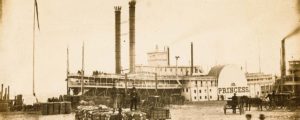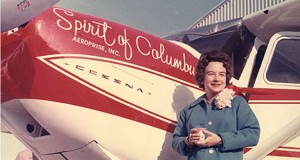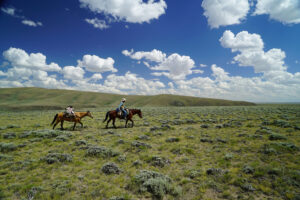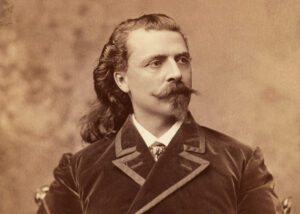To livery owners and undertakers, death meant a good living.
A hearse, above all things, is one of the most unpleasant jobs a coachmaker can have anything to do with, since it puts one in a very reflective mood when he sits down to design and study out a carriage which is to give him his last ride, provided he leaves the dimes behind to pay for it on this side of the grave.
So wrote Joseph Irving in the September 1858 issue of The New York Coach-maker’s Magazine. Making hearses might have been dismal work, but it would become a profitable business, as would hearse rentals.
In America’s early days funeral directors imported hearses from England, but craftsmen eventually copied the designs and made hearses in the States. Eastern livery stables rented out community hearses for as much as $50 for onetime use. Black plumes on the hearse were extra; the dead rich might get up to eight plumes, the dead broke one or none. Stable owners maintained a fleet of other funerary vehicles for the town’s well-heeled citizens. Livery stables also housed pallbearers’ coaches and flower carts for rental to the local undertaker—not that hearse ownership was limited to livery owners or undertakers. In 1825, for instance, 38 members of the First Presbyterian Church of Paterson, N.J., pledged $36.05 for a hearse “to be used for the accommodation of the members of this congregation—& also for the accommodation of others, when convenient.”
Hearses of any kind were a rare sight west of the Mississippi in the first half of the 19th century. When members of westbound emigrant trains died on the trail, the living usually buried them on the spot in a shallow grave. Even when homesteads and settlements first rose from the Plains, people transported the dead to family plots or local cemeteries by cart or farm wagon. Church, family and friends made the funeral arrangements, including transport of the dead. Undertaking in Western towns did not become its own profession until the 1860s. Eventually, though, manufacturers sent hearses west for use in the frontier communities, and funerals became commercialized, at least for well-to-do citizens.
In some places undertaking became big business. Nowhere was this more evident than in Butte, Mont., where 18 individual undertakers operated between 1885 and 1905. When a silver-mining camp in the mid-1870s, Butte City (later shortened to Butte) had a population of 1,000, but miners discovered copper on a nearby hill in the early 1880s, and by 1900 Butte was supplying the bulk of the world’s copper production and boasted a population of 30,000. Hearses were in constant demand in the boomtown. In fact, on January 19, 1895, it was reported that “all the hearses in the city” were needed for the funerals of nearly 60 citizens killed in the explosion of a downtown hardware store that had illegally warehoused gunpowder.
Makers and builders of carriages ultimately turned to the funerary business as a moneymaking proposition. Some had such success with their new line of vehicles that they discontinued carriagemaking altogether to focus exclusively on hearses. Three of the largest and most successful manufacturers were James Cunningham, Son & Co., of Rochester, N.Y.; Crane & Breed Manufacturing Co., of Cincinnati, Ohio; and the Riddle Coach & Hearse Co., of Ravenna, Ohio.
James Cunningham, Son & Co. offered custom features on its hearses, including emblems, bouquet-holders, gold-fringed white curtains with tassels and black-and-white plumes. In addition to the standard child’s hearse, the company developed and distributed its own unique hybrid, a combination coupe carriage and hearse, thus allowing parents to ride in the same vehicle as the body of their child. Cunningham manufactured the vehicles from tip to tail in its six-story carriage works.
Crane & Breed focused not on the hearse but the casket. Among the company’s unique offerings was an “airtight coffin of cast or raised metal” that resembled an Egyptian sarcophagus. It bore an exorbitant price tag of $50 to $100—compared to $2 for a simple wooden coffin—but the model sold well. The company also made its caskets from start to finish.
Riddle Coach & Hearse upgraded its carriage coaches to the highest possible standard and then added hearses to its offerings. The company brought in international artisans to render the fine carving and trim work. All construction was done by hand.
Those tight on money were limited to less-expensive hearses by lesser-known builders. Such vehicles often suffered from “over-ornamentation,” with cheap, gaudy carvings, poor-quality windows and a single horse to draw the vehicle.
Some individual hearses took on a life of their own, such as the “Black Moriah” of Tombstone, Arizona Territory, trimmed in gold and silver and one of eight such hearses made in 1881 by the Cunningham Co. at a cost of $8,000 apiece. The Black Moriah belonged to George R. Watt and Charles B.Tarbell, who operated Watt & Tarbell Undertakers at 418 Allen St. It is said that between 1881 and 1906 this hearse carried virtually all of the people who died in and around Tombstone to the Boothill cemetery. After the famous October 26, 1881, street fight near the O.K. Corral, the late Tom and Frank McLaury made their last ride to Boothill in the back of the Black Moriah, which is on display at Tombstone’s Bird Cage Theatre.
In the 1890s the Woman’s Improvement Association (WIA) of Las Cruces, New Mexico Territory, bought a hearse (the manufacturer and seller remain unknown). The WIA stored the black wooden vehicle with glass viewing panels at the Amador Livery, renting it out at $8 for in-town use and $10 for funerals elsewhere in Doña Ana County. The enterprising ladies used the funerary funds to make civic improvements in Las Cruces. The WIA hearse is sometimes referred to as the Pat Garrett hearse, as it is said to have carried the body of the sheriff who killed Billy the Kid in 1881. On February 29, 1908, an unknown assassin waylaid Garrett on the road from Las Cruces. As the lanky former sheriff’s body was too tall for any premade coffin in town, one had to be shipped north 45 miles from El Paso, Texas. Garrett was laid to rest in Las Cruces’ Odd Fellows Cemetery and moved to the city’s Masonic Cemetery in 1957. The hearse is on display at the Doña Ana County Sheriff’s Department’s Historical Museum of Lawmen.
Hearses, like other vehicles, would evolve in the 20th century. A 1914 Crane & Breed advertising brochure included the F.F. Woodall poem “Behold Me—The Hearse,” which included the following lines: “In the world I stand aloof from other transportation. None hire me for pleasure; none choose me for a ride; yet ne’er a one objects to take his outing. No passenger of mine hath ever damned the road or praised its smoothness.” By then hearses with electric motors had arrived, though probably not out West. The year 1909 saw the introduction of hearses with internal combustion engines, and a motorized hearse replaced the old WIA Pat Garrett hearse three years later. The frontier was all but gone, and the era of horse-drawn hearses was right behind it.
Originally published in the February 2013 issue of Wild West. To subscribe, click here.




